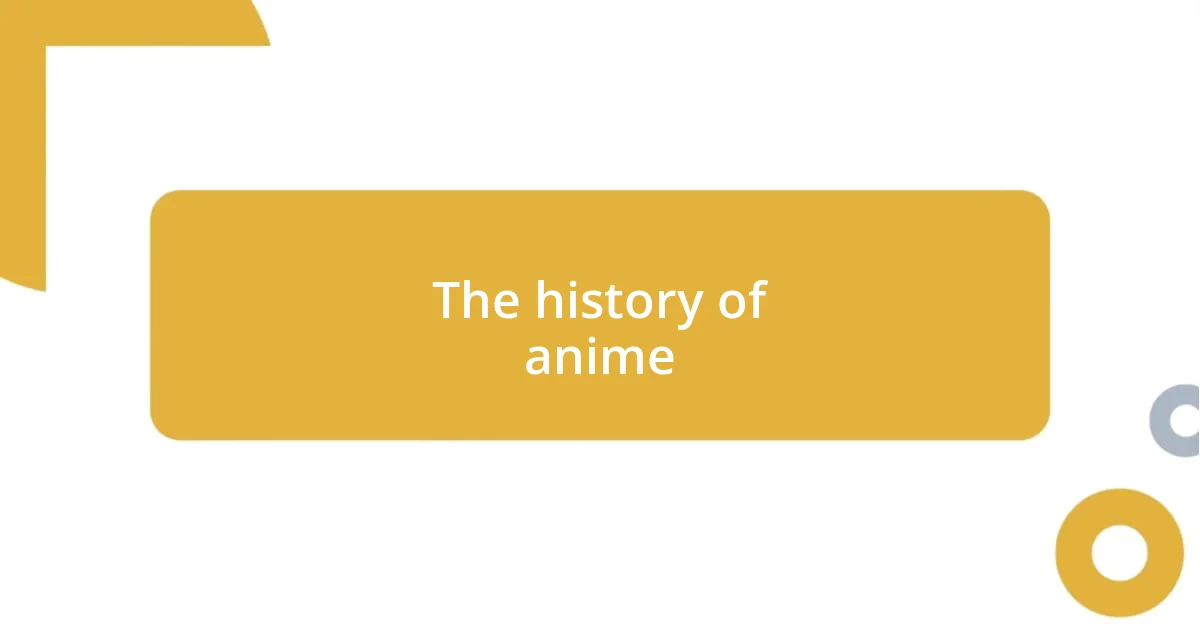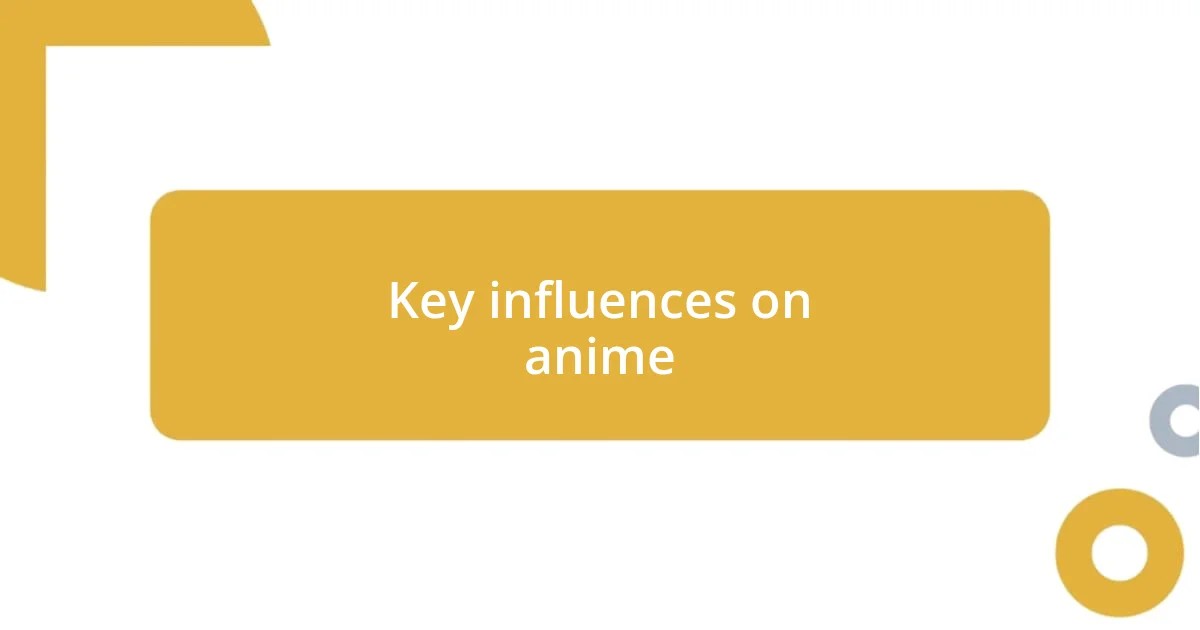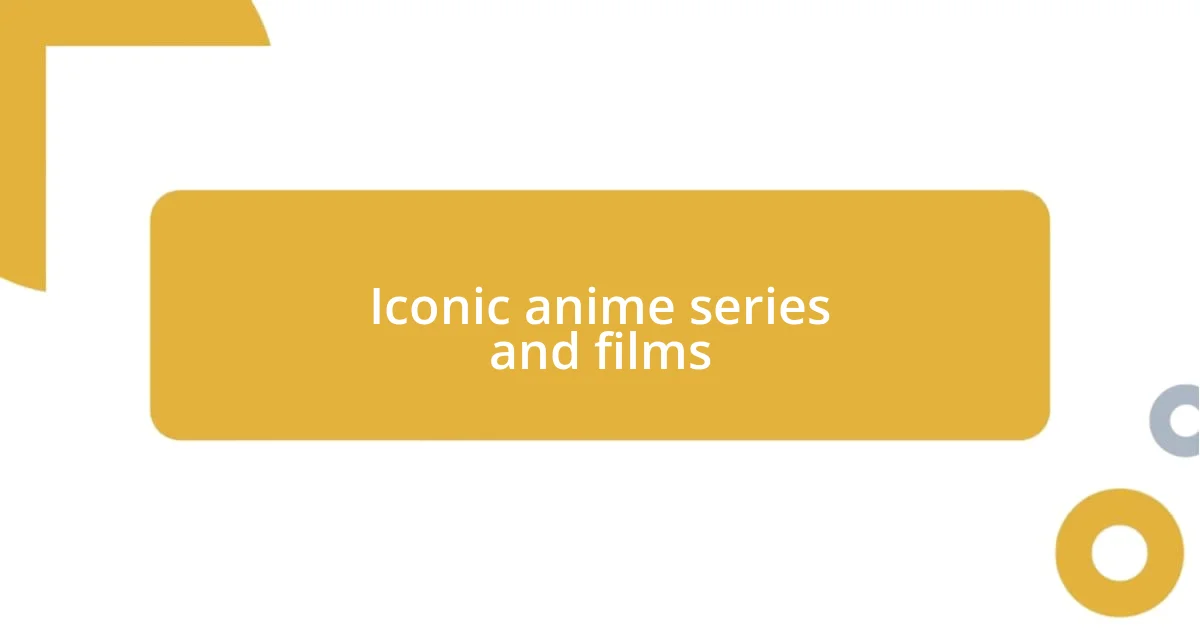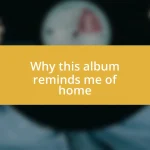Key takeaways:
- Anime originated in Japan post-World War II, evolving through the decades into a global cultural phenomenon with iconic titles like “Akira” and “Sailor Moon” defining its expansion.
- Key influences on anime include traditional Japanese culture, societal issues reflected in character depths, and the integration of Western media elements in narrative and style.
- The future of anime is poised for innovation with advancements in technology such as VR and a rise in diverse storytelling, promising richer narratives and enhanced animation quality.

The history of anime
When I first stumbled upon classic anime from the ’70s, I was captivated by the unique art style and storytelling, which set the foundation for what we now recognize as anime. It all began in Japan, where the post-war era saw the emergence of animated works, influenced by Western techniques but infused with distinctly Japanese storytelling. I often wonder: how did these early pioneers, like Osamu Tezuka, manage to create something so different yet timeless?
As the decades progressed, anime evolved dramatically. The ’80s and ’90s brought us iconic titles like “Akira” and “Sailor Moon,” which transformed the medium into a global phenomenon. I remember watching “Dragon Ball Z” after school, feeling such an adrenaline rush witnessing Goku’s battles. It’s hard to believe that this vibrant culture, which feels so contemporary, was born from a modest animation industry searching for its voice.
By the 2000s and beyond, anime had diversified into various genres, catering to all demographics. I can still recall the feeling of excitement watching “Spirited Away” and realizing that anime could offer something so profound and emotionally resonant. Isn’t it fascinating how a simple animation can evoke such depth of feeling? This journey from humble beginnings to a global influence speaks to the power of creativity and cultural storytelling that anime embodies.

Key influences on anime
When I think about the key influences on anime, the first thing that comes to mind is the significant impact of Japanese culture itself. Traditional art forms like ukiyo-e, a style of woodblock printing, contributed unique aesthetics to animation. I found it compelling how these historical influences shaped characters and settings in ways that felt both familiar and exotic. It’s like the rich tapestries of ancient Japanese stories were woven into the very fabric of anime.
Growing up watching episodes of “Neon Genesis Evangelion,” I recognized that the psychological depth of characters wasn’t just a random occurrence; it was a reflection of the complex societal issues prevalent in Japan during that time. I mean, who could forget the emotional turmoil faced by Shinji? It made me reflect on my own struggles with identity and connections. Such thematic richness is a testament to how anime can mirror and transform societal dynamics.
Additionally, Western media has undeniably played a role in anime’s evolution. Marvel and Disney movies have increasingly influenced narrative structures and visual styles. I remember the first time I noticed this in “My Hero Academia” – the blend of superhero tropes with traditional anime elements was exciting. It sparked my curiosity about how global influences can blend seamlessly into storytelling, creating something fresh yet familiar.
| Influence | Description |
|---|---|
| Japanese Culture | Traditional art and storytelling shaped the aesthetics and character design of anime. |
| Societal Issues | Complex themes in anime often reflect the psychological dynamics of Japanese society. |
| Western Media | Hollywood narratives and styles increasingly permeate anime, creating innovative genre fusions. |

Major anime genres explained
As I dive into the world of anime genres, I find it fascinating how each one resonates with different facets of life. There’s something uniquely enriching about how these genres cater to a diverse audience. For instance, I remember my first experience with shōnen anime, like “Naruto.” It wasn’t just about ninja battles; it was a journey of friendship and perseverance that taught me valuable life lessons as a teenager. The relatability of the character’s struggles made it feel like I was on the journey with them, and that’s a powerful connection.
Exploring various genres helps us appreciate the full spectrum of emotions and themes within anime. Here are some major anime genres that stand out:
- Shōnen: Targeted toward young males, these stories often feature action, adventure, and the journey of self-discovery through competition.
- Shōjo: Geared toward young females, shōjo anime typically emphasizes romance, relationships, and emotional complexity.
- Seinen: Designed for adult men, this genre often explores darker themes and more intricate storylines, pushing the boundaries of both narrative and animation.
- Josei: Aimed at adult women, josei focuses on realistic portrayals of romance, work, and personal relationships, often with a more mature tone than shōjo.
- Isekai: Literally meaning “another world,” this genre has exploded in popularity, revolving around characters who find themselves in alternate realities, exploring themes of escapism and adventure.
I believe what truly makes these genres resonate is their ability to reflect our experiences, dreams, and emotions. For example, the slice-of-life genre reminds me of cherished moments from my everyday life, catching feelings of nostalgia that are both comforting and poignant. It’s remarkable how anime can encapsulate the essence of human struggles and joys, inviting us to share in these stories.

Iconic anime series and films
When I reflect on iconic anime series, “Cowboy Bebop” immediately comes to mind. This series transcended traditional storytelling with its fusion of genres—science fiction, western, and noir—and its exploration of existential themes. I remember staying up late to watch the episodes, often pausing to ponder the characters’ struggles with their pasts. Didn’t you find yourself attached to Spike Spiegel, feeling that deep sense of yearning for freedom and connection?
Another show that has left a significant mark is “Spirited Away” by Hayao Miyazaki. The unique storytelling and breathtaking animation drew me into a whimsical world, while the underlying themes of growth and facing fears resonated on a personal level. I still think about Chihiro’s journey as a reflection of our own coming-of-age experiences, don’t you agree? Every moment felt like a lesson wrapped in enchantment.
Films like “Akira” also stand out for their revolutionary animation and thought-provoking narratives. Witnessing the dystopian vision of Tokyo in a future ravaged by chaos made me appreciate how anime can push the boundaries of art and storytelling. It sparked my curiosity about societal issues, asking questions about technology and humanity’s connection to it. I wonder if these portrayals have inspired the creators of today to challenge norms in similar ways?

Anime’s global reach and fandom
I’ve noticed that anime’s global reach has truly transformed the landscape of fandom over the years. Growing up, I had a small group of friends who shared my obsession, and now I see communities sprouting worldwide, connecting fans through conventions, online forums, and social media. It’s so exhilarating to engage with people from different cultures, all bound by a shared love for animated storytelling.
What really stands out to me is how anime has become a catalyst for cultural exchange. I remember attending an anime expo for the first time, and being mesmerized by the diverse range of cosplays and merchandise from fellow fans globally. It feels like we’re all participating in a vibrant tapestry, stitching together our unique backgrounds while reveling in our favorite characters and narratives. How profound is it that a series like “Attack on Titan” can provoke discussions on themes of freedom and identity across so many different languages and cultures?
Moreover, the influence of anime isn’t confined to just entertainment; it spills into art, fashion, and even lifestyle choices for many enthusiasts. I often find myself experimenting with Japanese recipes inspired by shows I love, turning meals into a celebration of those delightful narratives. Don’t you think it’s incredible how a simple animated series can inspire such a diverse and passionate global community? It’s this connection, through both shared experiences and cultural curiosity, that makes being part of the anime fandom so enriching and unforgettable.

Future trends in anime evolution
As I consider the future trends in anime evolution, it’s fascinating to see how technology is shaping the medium. The incorporation of virtual reality (VR) feels like it’s just on the horizon, and I can’t help but imagine the immersive experiences we might enjoy. Remember when I first experienced VR gaming? The feeling of being inside a different world was incredible—can you picture that kind of engagement with a character’s journey in anime?
One of the trends I’m excited about is the rise of diverse storytelling. With an increasing number of creators from various backgrounds stepping into the industry, we can look forward to narratives that explore a wider array of cultures and experiences. I remember the first time I watched an anime that explored themes of gender identity; it felt so refreshing and resonated deeply with my own experiences. Isn’t it empowering to think how this inclusion will enrich the anime narratives of the future?
Also, the animation quality continues to soar as studios experiment with new techniques. I recently marveled at a short film that blended traditional hand-drawn animation with CGI elements; the result was breathtaking. It made me wonder, how far can we push the boundaries of visual storytelling? I believe we’re only scratching the surface of what’s possible, and I can’t wait for these groundbreaking innovations to unfold in upcoming series and films.













